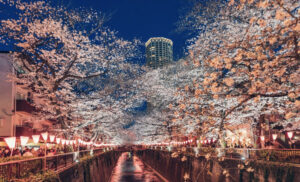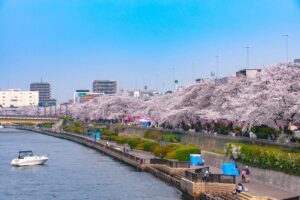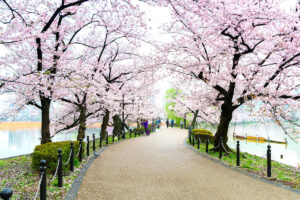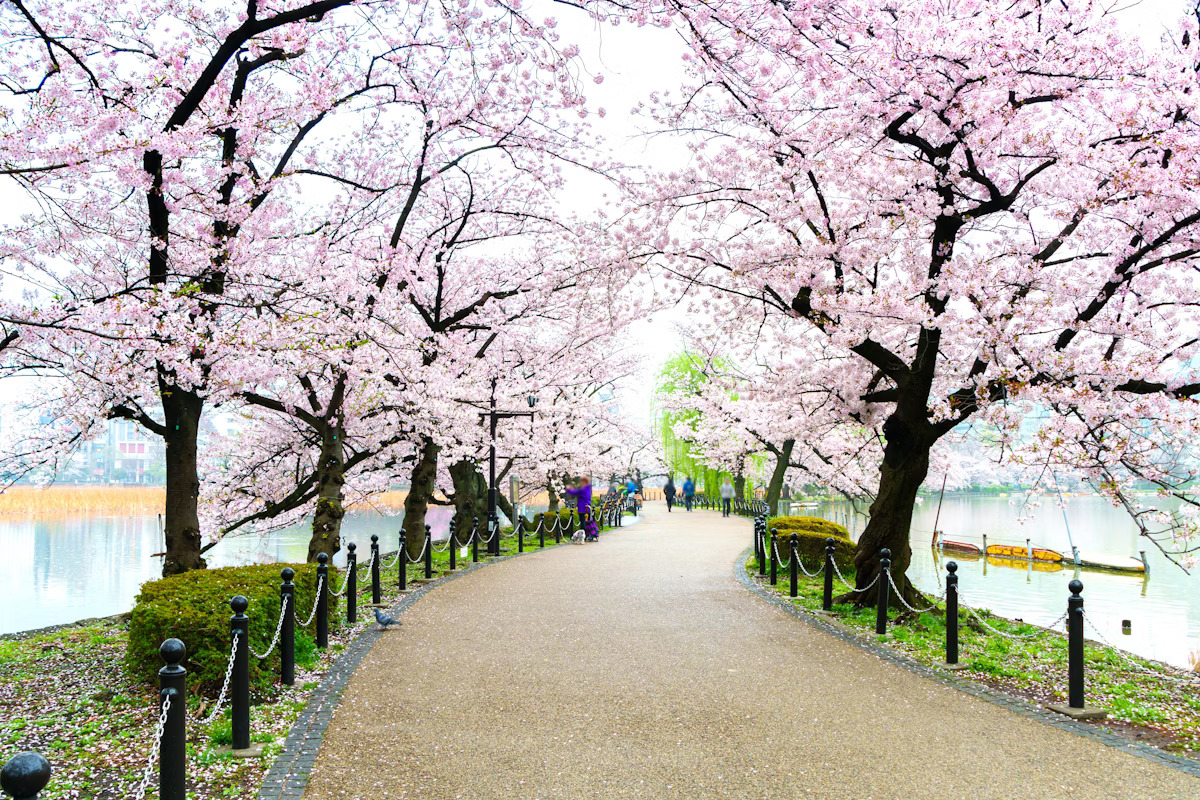Tokyo in spring is a vibrant and enchanting destination, primarily known for its breathtaking cherry blossoms, hanami parties, and lively festivals, which make this season the busiest time of year to visit Japan. As the cherry blossoms bloom, the city transforms into a picturesque landscape, attracting tourists and locals alike to participate in hanami gatherings beneath the stunning sakura trees. However, beyond the iconic cherry blossoms, Tokyo offers a plethora of activities and attractions that cater to all interests.
Visitors can explore historic sites such as the serene Senso-ji Temple in Asakusa, experience the bustling energy of Shibuya Crossing, or indulge in world-class shopping in districts like Harajuku and Ginza. Additionally, Tokyo’s culinary scene is a must-try, featuring everything from traditional izakayas to Michelin-starred restaurants. Art enthusiasts can immerse themselves in the city’s diverse galleries and museums, including the Mori Art Museum and the Tokyo National Museum.
Whether you are seeking cultural experiences, culinary delights, or simply want to enjoy the beauty of the city, Tokyo in spring promises an unforgettable adventure filled with unique experiences beyond the cherry blossoms. Plan your visit now to discover the wonders that await in this dynamic metropolis!
Weather and Clothing in Tokyo During Spring
Spring in Tokyo brings mild and pleasant weather, with average temperatures ranging from 57°F (14°C) in March to 72°F (22°C) by early May. As the chill fades, residents and visitors flock outdoors to enjoy the stunning cherry blossoms, hosting hanami picnics in parks and gardens. Wooly hats and scarves are traded for lighter clothing, welcoming the warmth of the season. This time also heralds a variety of seasonal foods, with sakura-themed treats and fresh ingredients making their way into stores and food stalls. Experience the vibrant culture, delightful cuisine, and breathtaking blooms that make springtime in Tokyo unforgettable!
Here are a few tips on the best types of clothing to pack/wear for Tokyo in Spring:
- A warm coat and perhaps a scarf for the cooler winds in March
- A light jacket or sweater for evenings in April or May
- Long-sleeved tops, or light sweaters
- Cotton blouses
- Shirts
- Shawls or cardigans
- Jeans or thick pants
- Trainers or good walking shoes
Weather and Clothing in Tokyo During Spring
While spring is a busy time for international and domestic tourism in Japan, there are a few simple things you can do to reduce the stress of travel during this time and the hassle of mistakes or mix-ups during your stay.
- Book your accommodation and flights well in advance: Hotels will book up fast, especially ones that are central or within easy reach of sightseeing spots such as Ueno Park. This also goes for events or attractions you plan to see. Keep an eye on the websites and pick up tickets as soon as possible.
- Prices are generally higher in Spring: Springtime is extremely popular all over Japan, so it goes without saying that prices will jump too. Expect to pay more for accommodation, flights, train tickets, events and attractions, and even food and drink. Be savvy and plan ahead and keep this in mind and it shouldn’t be a problem.
- Mild-to-warm weather: While you’re traveling to or around Japan, be prepared for occasional spikes in temperature, especially towards the end of May. While temperatures are generally mild and very pleasant, it is not uncommon for a warmer day to come out of nowhere, Pack accordingly.
- Plan your attractions: Whatever you want to do in Tokyo, chances are a million other people would also like to do it as well in the most populous city on earth. If you can factor this into your visits you might save yourself some time in queues or crowds. Consider small changes like cherry blossom viewing spots at night or during the day in the week when it might be less busy.
- Hay fever: With spring comes hay fever season, there’s no escaping it wherever you go, and the pollen count in Tokyo can be high. Some suffer more than others during this time of year but many people find that a mask helps. You can pick them up cheap at most convenience stores.
- Spring cuisine: Since you’re visiting during this time you might as well make the most of the unique dishes that are on offer at this time of year. Japan is a country that embraces its seasons and this is reflected in its dishes. I’m not just talking about sakura-flavored ice cream and cakes, but keep an eye out for dishes made from spring foods. Take a look at the seasonal foods section below.
Cherry Blossom Spots
Cherry blossom season is one of the busiest times of the year to visit Japan. People gather from all over Japan and the world to admire these beautiful trees. Premium viewing spots get crowded very quickly, particularly during the last week of March and the first week of April when the season is usually at its peak. Your best bet is to make sure you get to your desired viewing location early in the morning. For easy access to the best cherry blossom spots, you could try to book your accommodation close by. For example, the Nohga Hotel in Ueno is close to one of the best cherry blossom viewing spots in Tokyo, Ueno Park.
1. Meguro River (Day or Night)

If you have time for just one spot to go cherry blossom viewing this spring, make it a trip to Tokyo’s Nakameguro for a magical stroll along the Meguro River. This central Tokyo neighborhood is particularly well known for its cherry blossom viewing event which runs either side of the river between late March and early April.
Just a few minutes walk from Nakameguro station on the Hibya line, the scenic riverside stretch is lined with approximately 800 pink and white sakura trees. Allow plenty of time to stroll through the dense crowds, especially if you stop for photos, or food and drink from the stalls along the way. One thing to note, there is usually a walking direction system in place, so be sure to follow the direction of the crowd. Finally, don’t miss the chance to see the area lit up at night as lanterns line the footpaths and bring the brilliant pink trees to life. Whilst you’re in the area you could also stop by the giant Starbucks Roastery for some sakura-themed drinks!
- WHERE & WHEN: Meguro, Meguro City, Tokyo, late April.
2. Sumida Park

During springtime in Tokyo, you can find 500 cherry trees along both banks of the Sumida River, planted around 300 years ago by shogun Tokugawa Yoshimune. Sumida Park, which straddles a section of the river, has been a popular place for cherry blossom viewing since Japan’s Edo period. In addition to the riverside walk, you can also enjoy panoramic views of the ancient trees and the city from a traditional yakatabune boat as it drifts lazily down the river towards Tokyo Bay.
During the day, many Tokyoites enjoy spending time under the cherry trees, often bringing drinks and snacks to share. These kinds of gatherings or picnics are called hanami parties, which we’ll explore further below. At nighttime the trees are lit by spectacular pink and white lights, offering magical views. You also won’t want to miss the sight of the nearby Tokyo Skytree also lit up in pink and white during this special time.
- WHERE & WHEN: The southern end of Sumida Park can be reached via a 1 or 2-minute walk from Asakusa station, you will find the river on your right. The peak viewing time of the year at Sumida Park is late March to Early April. It is best to try to visit during the day on a weekday when the crowds are smaller.
3. Shinjuku Gyoen

One of the most beautiful parks in Tokyo, Shinjuku Gyoen National Garden can be reached via a 10–15-minute walk from Shinjuku Station. The spacious and beautifully maintained gardens provide a serene escape from the busy city, and during spring the pink and white petals of more than 1,000 cherry trees speckle the green landscape drawing in thousands of admirers.
Keep in mind, that although hanami parties are popular within the park, alcohol and smoking is prohibited onsite.
- WHERE & WHEN: Shinjuku Gyoen National Garden, Naitomachi, Shinjuku City, Tokyo, from late March to mid-April.
4. Ueno Park

There are few locations in Tokyo as beautiful as Ueno Park during cherry blossom season when more than 1,000 cherry trees turn the public park into a sea of pink and white. From around the last week of March to the first week of April, the Ueno Park cherry blossom festival becomes one of the busiest viewing spots in the city.
One of the best places in Ueno Park to see Sakura is Sakura-dori. The main avenue is well known for its rows of cherry trees and has been known to host more than a million visitors at peak times. It is worth noting that the exact dates of the festival are not known until much closer to the season when the trees begin to bloom, but you can keep track via the link below to help with your schedule.
- WHERE & WHEN: Ueno Park, Taito City, Tokyo, late March to early April 2024
5. Yoyogi Park
Yoyogi Park is another popular spot for cherry blossom viewing and hanami parties, due to its central location in Shibuya and proximity to attractions like the Shibuya Scramble Crossing and the famous Meiji Jingu shrine. Many thousands of people visit the park each season to enjoy more than 600 cherry trees.
The main entrance to Yoyogi Park can be easily reached a few minutes’ walk from Harajuku Station accessible via the JR Yamanote line. Entrance to the park even during peak season is free however, the park can become very busy during the season even on weekdays because of its central location, so be prepared to get there as early as possible or be willing to brave the crowds.
- WHERE & WHEN: Yoyogikamizonocho, Shibuya City, Tokyo, from around March 25. Arrive early on weekdays to avoid the worst of the crowds.
6. Chidorigafuchi Park
This small but beautiful park is perhaps best known for the rows of cherry trees that line the banks of the Imperial Palace moat. Rowboat rentals are also available from the beginning of March, offering visitors a different perspective of these dazzling trees from the water. Then, towards the end of April, the petals fall, covering the water in pink and white.
In the evening, when the trees are illuminated, visitors can wander the path alongside the moat to admire the shades of pink and white as the sun sets. Although stunning, Chidorigafuchi Park can become extremely busy due in part to its proximity to the Imperial Palace which is also a popular attraction, so be sure to arrive before 8 a.m. for the best unobstructed views.
- WHERE & WHEN: 1 Chome−2, Kojimachi, Chiyoda City, Tokyo. Rowboat rentals from the beginning of March, peak sakura viewing from the end of March to the second week in April.
7. Sakura Boat Rides
Aside from hanami parties and festivals, another more relaxing way to enjoy the fleeting beauty of cherry blossom season is by boat. You can float along the Meguro River between mid-March and mid-April during the cherry blossom festival and enjoy the brilliant tunnel of pink that stretches over the canal. Or rent a rowboat and explore the 700-meter-long moat that circles the Imperial Palace as hundreds of different varieties of sakura trees lean over the water.
Alternatively, you can enjoy the cherry trees that line the Sumida River in central Tokyo day or night, on a traditional Japanese yakatabune which passes beneath the Rainbow Bridge before coming out into Tokyo Bay.
- WHERE & WHEN: Between late March and early April is the peak sakura season for tour boats.
8. Seasonal Foods
Japan is big on embracing whatever the seasons have to offer within its cuisine, and the spring season is no exception. Here are a few dishes for you to try during your travels!
Many traditional restaurants in Japan serve takenoko, bamboo shoots, or takenoko-themed dishes during spring. Bonito fish are also popular in spring due to them being leaner and generally tastier than those caught later in the year. Seared bonito fish served with onions and garlic also known as katsuo no tataki, is a popular dish from Kochi prefecture.
Strawberry season takes place during late winter and spring and can be enjoyed just about everywhere. Many cafes and bakeries offer selections of delicious strawberry-themed cakes and desserts to feast on.
Lastly, you will also find many sakura-flavored foods around Japan throughout March and April. Delicate sweet treats such as sakura mochi are popular as well as different kinds of sakura cakes, and pink sakura-flavored ice cream. And don’t forget to try one of the many sakura-themed drinks that Starbucks Japan offers this time of year.
9. Spring Souvenirs
Omiyage, the Japanese word for souvenir, is the tradition of giving gifts to your friends, family, or work colleagues after returning from a trip. It is usually edible, although not exclusively, and often reflects the place you have been. While many stores offer a wide range of beautiful and delicious omiyage to pick up on your travels year-round, in the spring season you are likely to see many sakura or plum-flavored themed omiyage gift boxes, particularly in train stations around Tokyo. These make great gifts for someone back home and are always beautifully wrapped and presented.
When looking for gifts in Japan to take home either for yourself or for others, try to make the most of the season, there are many edible items for example, which are particularly popular or harvested in the spring, making them a perfect gift item. One such item is matcha. Between late April and early May, the leaves that are harvested are considered the best quality and most sought-after.
Another uniquely Japanese gift that is best enjoyed during spring is sake. Sake is fermented during the winter, making spring the best time of year to enjoy it freshly made. Cold sake is a refreshing warm-weather drink making it a popular choice at hanami parties.
10. Hanami Events
Hanami is the popular custom of flower viewing in Japan, which is closely tied to viewing both cherry and plum blossoms. It usually involves bringing along drinks and snacks to a cherry blossom site to enjoy with others under the colorful trees and can take place during the day or night.
While many hanami parties can be private gatherings or small groups, some sites put on their own cherry blossom festivals which are essentially large hanami events. You can often find stalls selling food and drinks, and visitors can bring their own blankets to sit under the trees and enjoy the surroundings. If you’re interested in throwing your own private hanami party, check out my article How to Hanami Like a Local, for more tips and information. It is important to note, that out of the many beautiful sakura viewing spaces in Tokyo, many do not allow private hanami parties, so it is always important to check first.
- WHERE: Popular hanami-friendly spaces in central Tokyo include Ueno Park, Yoyogi Park, Meguro River, Shinjuku Gyoen (Alcohol is prohibited), Sumida Park.
11. Sakura & Strawberry Buffets
Cherry blossoms aren’t the only seasonal item on the menu during springtime, as the strawberry growing season lasts from the New Year and into May. While many restaurants, cafes, and bakeries will be making full use of the popularity of sakura-themed treats, several high-end hotels also prominently feature strawberries alongside sakura as part of their spring buffet menus.
Some of the high-end hotels that regularly offer elegant strawberry and sakura-flavored all-you-can-eat dessert buffets and afternoon tea experiences during the spring season include the Grand Hyatt, Hilton, The Westin, and Conrad, to name a few.
Prices can vary between 3,000 and 8,000 yen and as these events are so popular, pre-booking is required. Keep an eye out on the below hotel websites around early March to find out more about how to book.
- WHERE & WHEN: Strawberry-themed dessert buffets are generally available to book from around late February, but this can vary between hotels.
12. Hitachi Seaside Park
Cherry blossoms aren’t the only buds to bloom during springtime in Japan. The most popular spring flowers at the Hitachi Seaside Park are the stunning fields of blue nemophila which are usually in full bloom from late April.
There are a wide variety of other beautiful blossoms to enjoy between March and April, including a field of 500,000 brilliant yellow rape blossoms, and 230 varieties of colorful tulips. Along with the incredible and photogenic flower fields, the park also offers a small amusement park, mini-golf, and rental bicycles to enjoy. While not strictly in Tokyo, Hitachi Seaside Park can easily be reached on a day trip from Japan’s capital by catching the 75-minute JR Joban Line Limited Express train from Shinagawa Station to Katsuta Station, and from there, a local bus will take you the final 15-minute stretch to the park.
- WHERE & WHEN: 605-4 Onuma-aza, Mawatari, Hitachinaka, Ibaraki 312-0012
Festivals
13. Asakusa Yabusame
The famous Japanese horseback archery, known as Yabusame, dates back more than 800 years when skilled archers on horseback attempted to hit small targets while moving at high speeds for competition. It was a common way for many samurai to sharpen their skills outside combat.
During the Edo period, the annual festival at Asakusa was held at the beginning of January as part of New Year celebrations, but today it is held on the third Sunday in April. The festival includes Kusajishi, a standard archery demonstration that takes place in the morning between 11:45 AM and 12:45 PM, and Yabusame, horseback archery which follows from 1:00 PM to 2:30 PM.
While there is a large amount of seating available for both events, it usually draws quite large crowds, so it is recommended that you arrive early if you want a good view. It’s also important to note that Kusajishi is free to watch, however, the more popular Yabusame competition requires a ticket which can be purchased at the link below.
- WHERE & WHEN: Sumida Park, Mukojima, Sumida, Tokyo, third Sunday in April
14. Meiji Jingu Grand Spring Festival
In late April, Meiji Shrine holds its annual week-long spring festival during Golden Week in dedication to Emperor Meiji and his wife Empress Shoken who are enshrined there.
The event features a variety of elegant and culturally important performances in their honor, including an ancient Japanese imperial court dance known as Bugaku, classical Japanese theater music, and dance performances known as Noh and Kyogen, a Kyudo tournament (Japanese archery), and performances of biwa (a traditional Japanese lute), and other traditional artists. The shrine’s large and exquisite gardens are also open to the public where you can enjoy the beautiful seasonal flowers coming into bloom.
- WHERE & WHEN: Meiji Jingu, 1-1 Yoyogikamizonocho, Shibuya, Tokyo, late April to early May
15. Kanamara Penis Festival
One of Japan’s more *ahem* unusual festivals is the Kanamara Matsuri, also known as the ‘Festival of the Steel Phallus’, an annual parade that sees thousands of tourists gather to watch the Mikoshi parade, portable shrines containing giant phalluses that are proudly carried through the streets of Kawasaki.
The festival is centered around Kanamaya Shrine which honors the god Kanayama-hiko and the goddess Kanayama-hime who are known, among other things, to bring fertility and good fortune to married couples, as well as protection from STDs. During the festival, novelty penis-shaped snacks, sweets, and decorations are available to purchase from vendors along the route of the parade, with all the proceeds being donated towards HIV research.
- WHERE & WHEN: Kanayama Shrine, Kawasaki, on the first Sunday in April




